The NVIDIA GeForce GTX 650 Ti Review, Feat. Gigabyte, Zotac, & EVGA
by Ryan Smith on October 9, 2012 9:00 AM ESTPower, Temperature, & Noise
As always, we’re wrapping up our look at a video card’s stock performance with a look at power, temperature, and noise. Unlike GTX 660, GTX 650 Ti does not have GPU boost, which means the GTX 650 Ti’s load voltage is fixed at a single value. This is more important for overclocking, but because NVIDIA is not trying to min-max performance by sacrificing some power consumption, it allows the GTX 650 Ti to really turn down its power consumption. As a reminder, NVIDIA’s TDP here is 110W, with no power target (though NVIDIA throws around a “typical” number of 80W).
| GeForce GTX 650 Ti Series Voltages | |||||
| Ref GTX 650 Ti Load | EVGA GTX 650 Ti Load | Zotac GTX 650 Ti Load | Gigabyte GTX 650 Ti Load | ||
| 1.087v | 1.05v | 1.087v | 1.087v | ||
Without GPU boost voltages are quite low for desktop GeForce 600 cards. Instead of spiking at 1.175v we’re seeing a range from 1.05v to 1.087v. Meanwhile the idle voltage is typical for a GK106 card at 0.875v.
While we’re on the subject of voltages, it’s worth noting that while NVIDIA doesn’t have GPU boost active, this doesn’t mean they’ve thrown away Kepler’s power management system. Specifically there’s still a hard 1.175v ceiling, and at high voltages NVIDIA will still step down the voltage based on temperature in order to combat leakage. When overvolting our reference GTX 650 Ti we saw voltage step downs at a relatively low 56C, and another at 74C. This only applies to overvolting though, and there’s no corresponding reduction in clockspeed in any scenario.
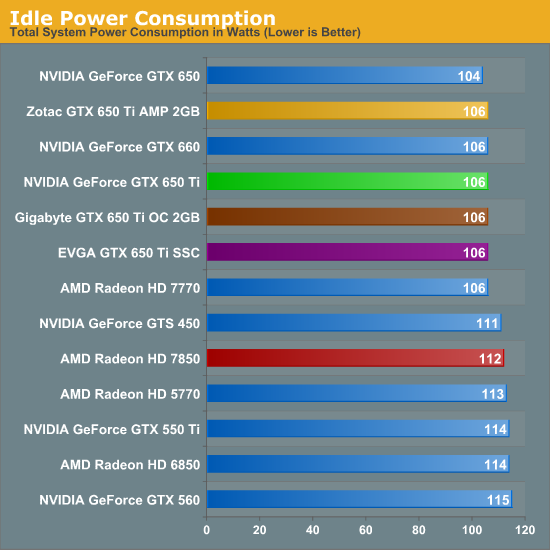
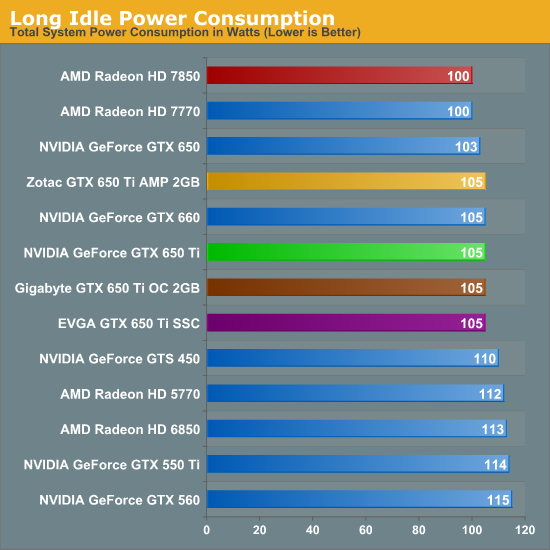
Starting as always with idle, having already seen the GK106 based GTX 660 there are no grand surprises here. Even with the disabling of some functional units the GTX 650 Ti doesn’t do any better than the full-fledged GTX 660, which is not to say that this is bad. At an NV estimated idle TDP of 5W this is still better than the 7800, and is good enough to tie the 7770. The factory overclocked cards fare no worse here either, all of which lead to our testbed hitting the same marks at the wall.
The one place NVIDIA can’t compete is in the long idle scenario with no active displays. The 7800 series still has a 5W advantage at the wall, though the benefits of something like AMD’s ZeroCore technology are not nearly as great here since the GTX 650 Ti can’t be SLI’d (and hence have a headless card).
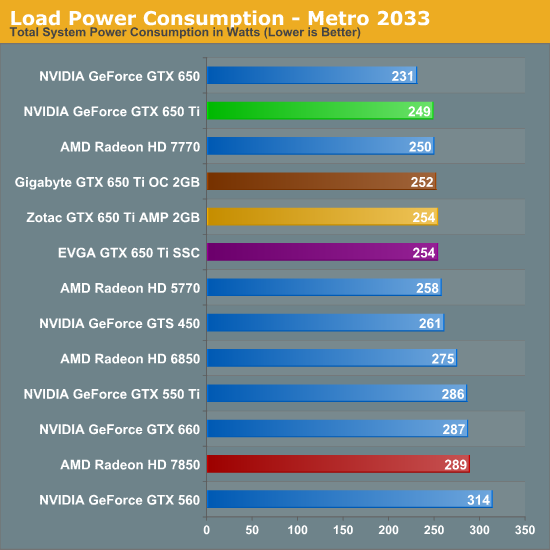
Moving on to load power consumption we’re finally seeing a test where the GTX 650 Ti has a clear architectural/design advantage over the competition. Though not strictly comparable, the 7850 has an official TDP of 150W versus 110W for the GTX 650 Ti, a difference of 40W. Meanwhile under Metro the gap between the 7850 and the GTX 650 Ti is exactly 40W (before taking into consideration PSU efficiency of course). Paper specs aside the GTX 650 Ti is clearly intended to be a lower power card than the 7850 and here it delivers. If it can’t beat the 7850 in performance then it is going to need to beat the 7850 on power consumption.
Meanwhile our factory overclocked cards present an interesting lineup. All 3 are closely clustered together in spite of the fact that the Zotac and Gigabyte cards have an extra 1GB of GDDR5 RAM to power. GDDR5 has quite the reputation for being a power hog (for a RAM), so it’s a bit surprising not to see a greater difference. The biggest driver of any power increase seems to be the overclocks themselves, leading to the marginally lower value we see for the Gigabyte card.
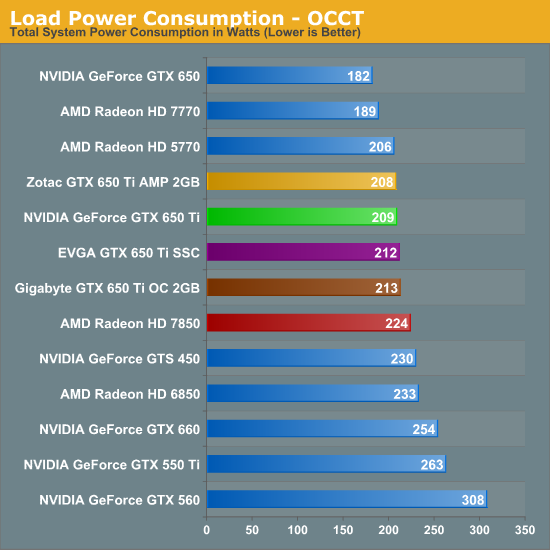
Turning to OCCT, the GTX 650 Ti doesn’t maintain the same large lead over the 7850 that it did with Metro thanks to AMD’s more aggressive throttling (and without GPU boost NVIDIA may as well not have any throttling), but reinforcing the fact that these cards are in two different power classes the GTX 650 Ti still ends up drawing less power. In fact it draws less power than the GTX 550 Ti or the GTS 450, the latter of which is not typically a high power card. Even without GPU boost – or perhaps especially without GPU boost – NVIDIA’s high power efficiency is maintained, though at a cost of rendering performance notably weaker than the immediate competition.
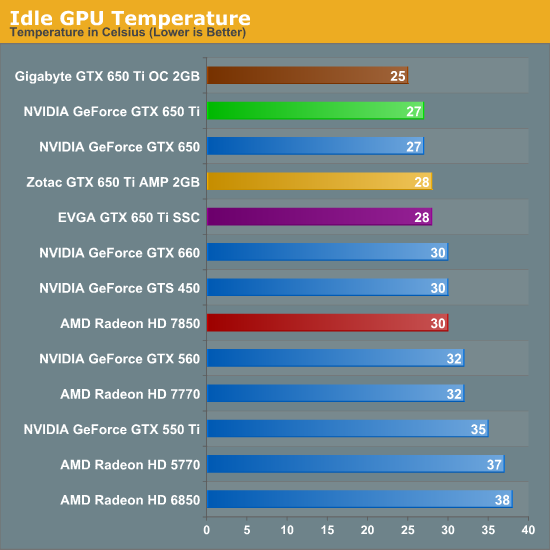
A low power GPU combined with open air coolers often leads to very low idle temperatures, and the GTX 650 Ti lives up to that tradition. It’s simply not that often that we see GPUs hit temperatures only a couple of degrees above room temperature. And in the case of Gigabyte’s card with its oversized that’s the lowest idle GPU temperature we’ve ever recorded, once more proving that there’s no kill like overkill.


Moving on to load temperatures we get to see the effectiveness of an open air cooler combined with the relatively low power consumption of the GTX 650 Ti. At 59C under Metro and 65C under OCCT our reference GTX 650 Ti holds up amazingly well, and just wait until we get to the noise readings, since this is where the GTX 650 Ti and 7850 will really stand apart. Meanwhile even with their similar designs the EVGA and Zotac cards both end up being a bit cooler, than the reference GTX 650 Ti. But the real winner is the Gigabyte card and its oversized cooler; 43C with Metro is unheard of, and 50C with OCCT is as equally impressive.

Transitioning to noise measurements we start with idle noise, where there is no great surprise as most cards have long since ceased having loud idle states. The EVGA card is a bit disappointing though, since there’s no great reason why such an open air card should be much above 41db(A).
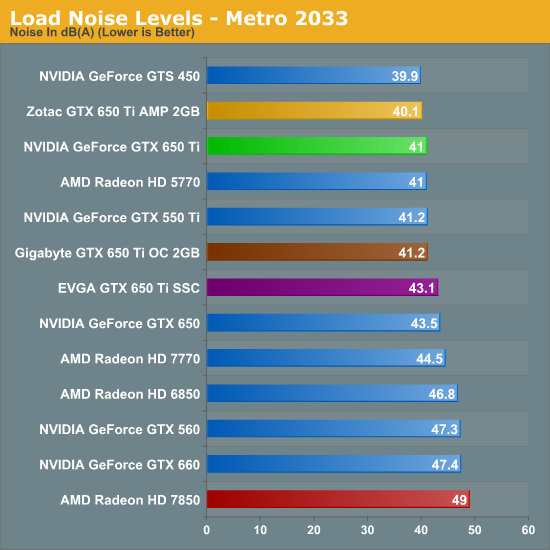
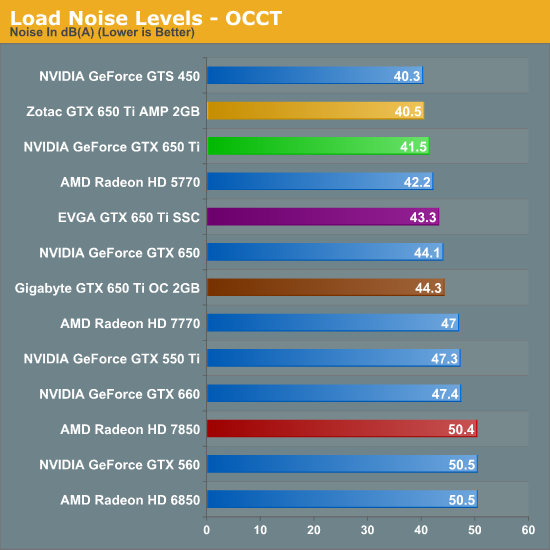
Taking a look at load noise we finally get to see the full picture. Earlier we had high praises for NVIDIA’s reference design, and this is the reason why. NVIDIA almost always hits a good balance between power, temperature, and noise, and nowhere is this more evident than with the GTX 650 Ti. Peaking at 41.5db(A) with OCCT it barely gets off of the noise floor. Meanwhile AMD’s reference 7850, complete with its blower, is almost 9dB(A) louder. Open air non-reference 7850s won’t be nearly as loud, but this is a reminder of what open air coolers can do, particularly when power consumption is low enough.
The real winner for load noise generation however is not NVIDIA’s reference design or even the Gigabyte card and its oversized cooler; it’s Zotac and their fairly plain open air cooler. Admittedly we’re looking at just a 1dB(A) difference, but if noise is crucial the Zotac card looks particularly good. Meanwhile the EVGA card, though starting out rough, doesn’t end up doing too poorly at load here. 0.3dB(A) is a tiny increase in noise over idle and it’s actually good enough to be in the middle of the pack for our retail cards.
The surprising result is the Gigabyte card, which should have the easiest time cooling. It looks like Gigabyte’s fan curve is a bit more aggressive than the rest of the GTX 650 Ti cards, which helps explain its amazingly low load temperatures, but that means there’s a noise tradeoff. Given the temperatures we’re seeing, Gigabyte was a little too aggressive with their fan curve; had they not then they could have easily swept this entire section.










91 Comments
View All Comments
chizow - Tuesday, October 9, 2012 - link
On second glance, the AC3 bundle makes the $150 MSRP palatable. While I agree a straight MSRP or $20 MIR at the $130 price point would have been more preferable for many, a bonafide AAA title like Assassin's Creed 3 prior to release is suitable currency. Market value for the game code is at least $20-30 (going by historic FS/Ebay prices of similar AAA title Steam codes) and up to $50-60 for anyone who was going to buy the game at release anyways.Personally I'm shocked Nvidia would bundle a such a relevant game code like this with a value part in the $150 price market. Hopefully the generosity filters upward to the GTX 660 and above as the 660 never got a bundle and the BL2 promo on 660Ti and faster parts seems to have dried up at most retailers.
RussianSensation - Tuesday, October 9, 2012 - link
Ok and what happens after you beat AC3? You get a card that tanks in GPU demanding games.7850's minimum frames rates are nearly as high as average framerates in games like Crysis 1/2, Skyrim, Witcher 2.
http://www.bit-tech.net/hardware/graphics/2012/10/...
You buy a GPU to play 100s of games not 1 game. NV bundled a game on purpose so people would use this argument that well the card is $150 but you get a $50 with it. That's marketing right there. It's still a $150-170 card (if we include after-market versions) that has far slower performance than $160-190 competitor.
I think $129 would have been a far more reasonable price. Instead, NV delivered a card that has worse price/performance than either the 7770 or the 7850. And if we take 7850's overclocking into consideration, well then it's a total blowout as 7850 OC ~ HD7870/GTX580 in performance.
chizow - Tuesday, October 9, 2012 - link
"Ok and what happens after you beat AC3? You get a card that tanks in GPU demanding games."You still have a card that is $30-$50 cheaper than its MSRP because of the bundled AC3, so while it may not have been worthwhile at $150-$170, it would certainly justify its $120-$140 pricetag.
Whether you care to admit it or not, AC3 is a valid form of currency as by definition, currency is simply a medium for exchange. We're not talking about games nobody cares about here (See: Gaming Evolved titles), we're talking about some of the most anticipated games of the year on any platform with BL2 and AC3, bundled PRIOR to release while they are still relevant.
If you were in the market for AC3, you saved $50. If you don't care for AC3, you will be able to easily unload it for ~$30. That effectively reduces the price of the card from $150-$170 to $120-$140.
Blazorthon - Tuesday, October 9, 2012 - link
*wrong post with this above, oops*Don't forget, the 7850 comes with games and so does the 7770. Coming with a game is necessary just to compete right now. The 7770 also has some highly factory overclocked models that can inch out the 650 Ti while still being cheaper. The 650 Ti would do better at $10 or $20 lower and a MIR is a great way to accomplish that since a lot of people forget to do them anyway, but buy the card because of the after MIR price.
chizow - Tuesday, October 9, 2012 - link
The 7770 is bundled with Nexuiz....seriously why even bother mentioning it? What would you value Nexuiz at? $5? $10?Sleeping Dogs with the higher-end AMD cards is decent, still not as strong as Nvidia's BL2 promo, but yeah we are talking about AC3 here which will undoubtedly be a top 5 title for this holiday season.
The 650Ti has some OC'd models as well that bring it close in performance to the 7850 1GB, but of course, the 7850 distances itself again once OC'd. As I said, a $15-20 price drop would certainly make more sense for the 650Ti and I'm sure we'll start seeing some rebates in a few weeks as all of the higher-end GeForce models have started seeing them in recent weeks.
hqt4991 - Tuesday, October 9, 2012 - link
I don't know about you, but I am quite unsure that nobody cares about Far Cry 3, Medal of Honor: Warfighter, Hitman: Absolution, Sleeping Dogs, DiRT 3, Dragon Age 2, Saints Row The Third, the Tomb Raider remake or (especially) Bioshock Infinite. I know I do.On topic, I agree with Ryan. The 650 Ti isn't strictly a bad card, just that it doesn't make any sense to choose it over the 7850, unless you are absolutely cash-strapped.
chizow - Tuesday, October 9, 2012 - link
Here's the difference between those games you listed and the two latest promos from Nvidia:I would actually pay full retail price for BL2 and AC3 and did actually have BL2 pre-ordered prior to Nvidia's promo.
All the games you listed for Gaming Evolved I would pass on at launch or wait until they were $10 or less in a Steam sale. That's not to say they are bad titles and some may certainly feel differently, but to me and I'm sure many others, they do not carry the same value or currency as the last few games offered by Nvidia.
Also, afaik, only Sleeping Dogs was offered by AMD as a promo bundle, so until they start bundling some of the better GE titles there's really not much of a comparison to make.
Death666Angel - Wednesday, October 10, 2012 - link
"I would actually pay full retail price for BL2 and AC3 and did actually have BL2 pre-ordered prior to Nvidia's promo."So why are you two arguing about your video game taste? Someone values AC3 higher, someone values SD higher. It's a personal thing. I don't want either of those and am not a big fan of bundled software. So no added game would be a plus in my book.
chizow - Thursday, October 11, 2012 - link
Because video game tastes are a direct function of demand. I'm not just referring to my own video game taste, I'm making the point that AC3 is going to appeal to far more gamer's video game tastes which equates to higher demand for it at launch, and by extension, it's buy and sell price and demand will be much higher than any Gaming Evolved titles bundled with AMD cards.That brings us full circle to the comment he took issue with about games nobody cares about, its all about relevance and those games he listed are much less relevant to the vast majority of gamers, plain and simple.
CeriseCogburn - Friday, October 12, 2012 - link
Dirt3 is an amd promo bundle game, and my amd total fanboy buddy just said tonight he hates it because after you install it in order to get the real game you have to go buying all their packs and upgrades spending a buttload of money so it's nothing but crap.So there we have the amd marketing kickback extra expense for the disappointed amd penny pinching moaning poor boy amd fan...
LOL
It's funny because it's 100% true but also so freakin sad.